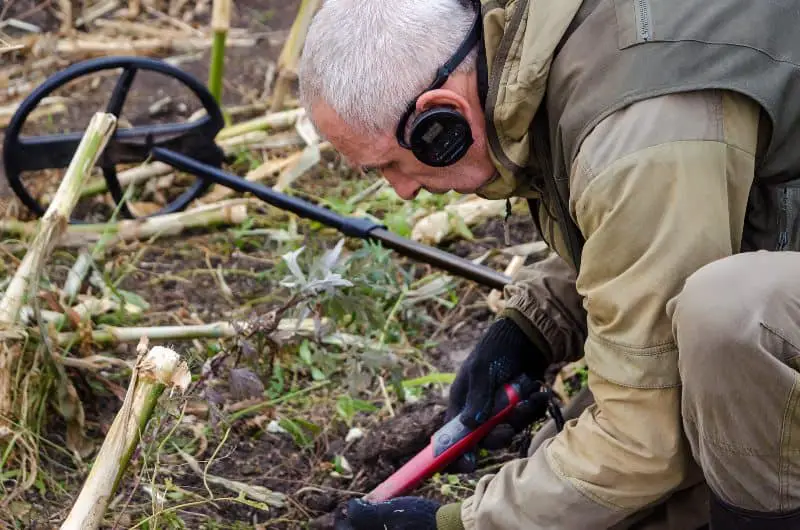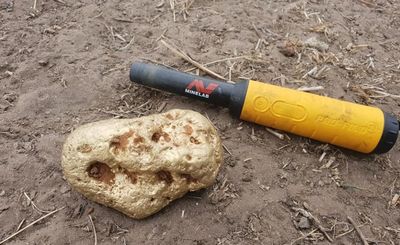
I’ve known some people with many years of metal detecting experience who have never used a pinpointer before! Obviously they were quite successful, but the question is, would they become even more successful if they’ve considered using a pinpointer in combination with their metal detector?
Yes. Indeed, pinpointers will help you save a ton of time digging for a target. Targets are usually stuck inside large blocks of dust and even if your metal detector gets a strong signal, you will still have to dig and find it among all that dust! Pinpointer will make that part much quicker, easier and straightforward.
This article will help you understand the real value that comes with using a pinpointer. Hopefully, I will convince you to use one!
Reasons why using a pinpointer is important …
While metal detecting and suddenly hit upon a hidden target, your pinpointer is definitely your best friend at that time!
Bellow some important benefits you will get if you use one:
1 – It will help you precisely and quickly locate your target. Otherwise, even if you dig up the soil, your target could still be anywhere in the hole, covered in dirt. A pinpointer will let you scan the hole quickly and retrieve your target.
2 – The retrieval process will be cleaner and easier. By knowing the exact location of your target, there is no need to dig a huge hole.
You can make a small one, remove only that much dirt, easily find your target and proceed with retrieving it without causing a big mess (locals and local authority won’t be mad at you)
3 – A pinpointer prevents damage to your treasure. A potential target often could be located at great depths below the ground, or it could be simply on the edge just underneath the ground
If it is well in the reach of your detector’s coil circumference, and you jab a shovel into the ground directly, you risk damaging the target!
Having a pinpointer lets you narrow down on the exact possible location of the treasure. So once you have dug up your hole, bring out a handheld pinpointer to find the treasure directly, thus minimizing the risk of damage to the treasure.
4 – You will increase the chances of finding small valuable targets. A pinpointer is great for finding small targets in fields, grassy areas, under floors, or even behind walls.
Features a quality pinpointer should have …
There are several features that you should look for in a good quality pinpointer. Lower-priced pinpointers might not come with all the features, while higher-end pinpointers are usually better if you are detecting in a rugged terrain.
Here are some of the features you should look for:
Quick recommendation: If you are looking for model that has all the features bellow. Then you should have a look at this Pinpointer Model. It comes from the Garrett house and is by far the most popular in the market.
1. Power Source: Most pinpointers use alkaline batteries as their power source. The most common options are either one or more AA batteries or a 9-volt battery.
Some models also come with rechargeable batteries. If you use your pinpointer frequently, buying a model with rechargeable batteries will save you a lot of money, especially if you are an avid treasure hunter.
2. Total Depth Rating: A pinpointer’s IP rating (Ingress Protection Rating) lets you know the waterproof depth of that model.
The size of the search coil and level of sensitivity are the main factors that impact target depth. Units with larger coils can detect deeper and high sensitivity in the pinpointers help you find targets deeper in the ground.
So pay attention to the total depth rating of your pinpointer while buying.
3. Is it Waterproof? Many times you end up detecting near or in the water. To help in metal detecting near or underwater, you need a waterproof or water-resistant pinpointer.
Again, the IP ratings will help you determine the degree of protection the unit has against water.
Pinpointers that are only weatherproof have ratings as low as IP 65 to IP 66. The ones that are fully submersible in water have ratings that are higher than IP 67.
4. Sensitivity: Most pinpointers have adjustable sensitivity. By increasing the sensitivity, you can detect targets located at a greater depth.
On the other hand, the depth range gets reduced with reduced sensitivity, and the pinpointer can locate targets more precisely. It is possible to select a pinpointer from a range of sensitivity levels.
Built-in pinpoint mode VS regular pinpointer
Today, metal detectors come with a variety of advanced features. Many of the middle and high-end detectors include a built-in pinpointing mode or control.
In such cases, many people wonder whether they need to buy an additional handheld pinpointer and which is better.
Having a built-in pinpointer in your metal detector with a large search coil will help you use it as a general screening device to locate the treasure.
However, a built-in pinpointer will not be of much help if you want to zero in on the exact location of your target.
Having a small handheld pinpointer will not only help you zero in precisely on the target, but it is also much easier to use this type of device inside the hole.
Also, a built-in pinpoint mode won’t let you isolate the target with accuracy. A separate pinpointer will precisely isolate the target and tell you whether it is located at the bottom, top, or sides of the hole you have already dug.
Will a pinpointer help finding expensive metals like Gold?

There are many high-quality pinpointers available on the market today. While most pinpointers are not sensitive enough to detect gold, there are some high-quality pinpointers like the Minelab Profind 35 (Check it Here at Amazon) and White’s Bullseye TRX that can help you detect gold.
It is important to realize that as the object gets smaller in size, the range of a pinpointer is reduced. Since even small pieces of gold can be of high value, a pinpointer to detect gold has to be sensitive enough to detect little gold flakes as well.
Almost any pinpointer can detect a gold nugget that weighs 5 grams or more without any problem!
However, if the gold nugget is broken into very small pieces or the pieces are placed close to each other, they will not be detected.
Similarly, gold rings, bracelets, or bars can be easily detected by a pinpointer, but a gold chain might not get detected as the individual loops are placed close to one another and not detectable by a pinpointer.
By the way, camping areas are really great if you looking to metal detect for stuff like gold jewelry!
How to use a pinpointer effectively?
Here is a step by step guide to using a pinpointer effectively:
Step 1: Turn on the pinpointer, but keep it facing away from any metal target/item. You will hear a series of beeping sounds that indicate it is turned on and it has turned itself to the ground conditions around you.
Step 2: If you are detecting in a highly mineralized terrain, put the tip of the pinpointer directly into the sand, soil, or saltwater.
Step 3: Now press the ground balancing button. In some models, this button might be named Calibrate, Retune, or other similar terms.
Step 4: If the pinpointer is experiencing more environmental interference or responses, retune it again or reduce the sensitivity.
Step 5: Begin scanning the hole you have dug or the general area you want to search in with the top of the pinpointer. Keep listening to the audio. Most pinpointers work on a proportional audio tone system.
This means the closer you are to an object, the faster the audio will beep or change in pitch. So keep moving the tip of the pinpointer towards the area from where the beeps get closer and faster together.
Continue moving towards this area until the beeps eventually change into a continuous tone. This indicates that you are within half an inch of the potential target.
Step 6: If your metal detector is detecting a target, but the pinpointer is not beeping, use your tools to dig deeper and again search with the tip of the pinpointer.
Step 7: If the pinpointer behaves erratically, repeat steps 2 or 3 to re-calibrate the unit.
Step 8: You can now recover your target based on the detection from your pinpointer.
Step 9: Switch off the pinpointer.
Can pinpointers help you find treasure underwater?
Depending on the model, it is possible to find treasure underwater with a pinpointer. One of the popular pinpointers that are waterproof up to a depth of 20 feet is the Garrett Propointer AT.
The Fisher F-Pulse pinpointer is also waterproof and fully submersible up to six feet underwater. The Treasure Products Vibra Probe 585 is waterproof and can work underwater up to 100 feet.
A pinpointer can be helpful for underwater detecting if you are hunting in streams or creeks, or the rapid flow of water is making it difficult to see the target.
One drawback of using a pinpointer underwater is that the sound of the rushing water makes it difficult to hear the pinpointer beeping …
However, many underwater pinpointers come with a vibrate setting that can be switched on and off as required. As you get near your target, the pinpointer starts to vibrate, letting you feel the vibrations in your hand.
Final Thoughts …
Are you convinced now that you should use a pinpointer every time you decide to go for hunt? Hopefully that’s the case …
If you are not that convinced, I advise you to borrow one from a friend for example and try it out for one hunt. Just one!
If you do so, I am sure you will be totally convinced that pinpointers are really really helpful while metal detecting.
